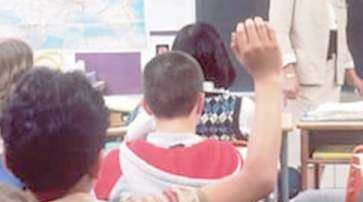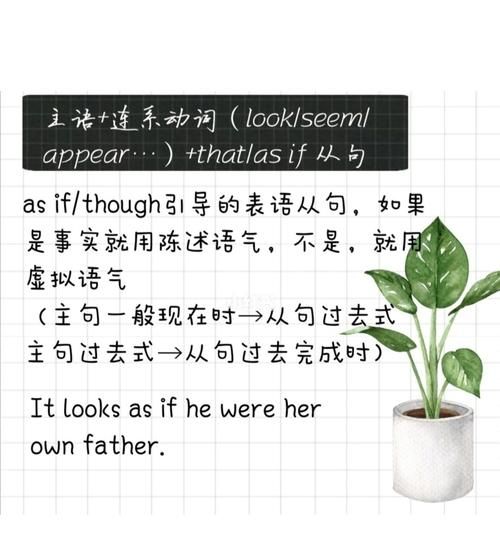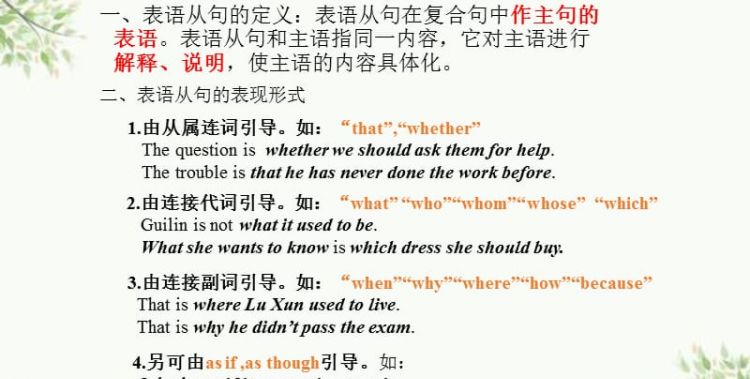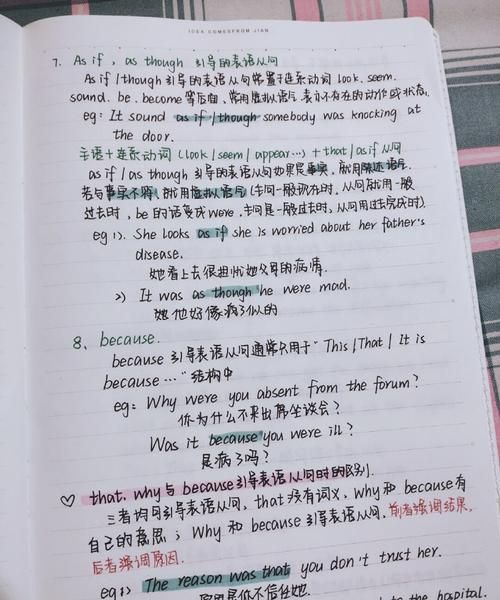本文目录
九年级英语语法笔记整理
英语语法公开课笔记整理
词 类 对单词的分类是根据单词在句子中所起的功能来分类的代词 动词 数词 形容词 名词 连接词 副词 介词 感叹词代词(pronoun pron.)

代指一类人,事或物的词。代词是少林派~动词(verb v.)
是用来形容或表示各类动作的词汇。动词——武当派数词(numeral num.)
数词是表示数目多少或顺序多少的词。形容词(adjective adj.)
形容词修饰名词或代词,说明事物或人的性质或特征。形容词——衡山派名词(noun n.)
名词是指待人、物、事、时、地、情感、概念等实体或抽象事物的词。名词——丐帮连接词(conjunction conj.)
连词是用来连接词与词、词组与词组或句子与句子、表示某种逻辑关系的词。副词(adverb adv.)、
副词是用来修饰动词、形容词、副词、介词、连词等单词或短语,以说明动作性质或状态的特征的词。副词——绿叶派介词(preposition prep.)介词——丐帮分派
介词又称前置词,在句中不单独作任何句子成分。介词后面必须有名词、名词性词组或名词性从句作它的宾语,构成介词短语。感叹词(interjection interj.)
感叹词是用于表达各种感情的词,与后面句子的'其余成分无语法联系。1 前六类叫实词,后四类叫虚词。
2 很多单词不仅仅属于一个词类。
3 有些词类可以继续细分。
① 名词及相关类(名词,代词,数词,冠词,介词,形容词)代词——替身派
② 动词及相关类(动词,副词)
③ 其他类 (叹词,连词)
句 子成 分 主 谓 宾 定 状 补 表 语 ~~~~主语
主语是句子所叙述的主体,是谓语讲述的对象,表示所说的“是什么”或“是谁”
名词及相关类(名词,代词,数词,冠词,介词,形容词)谓语
谓语是用来说明主语所做的动作或具有的特征和状态,说明主语“做什么”、“是什么”或“怎么样”。
人称和数上要保持一致。宾语
宾语是动作、行为的对象,表示动作的承受者,一般位于及物动词和介词后面。
①直接宾语和间接宾语:直接宾语是及物动词的对象;间接宾语表语动作是对谁做的。
eg.His father gave him a new pen.
直接宾语:a new pen 间接宾语:him
②宾语补足语是对宾语进行补充和说明的句子成分。make sb do sth
eg.The teacher asked the students to hand in their homework.
宾语补足语:to hand in their homework
“宾语+宾语补足语”合起来称为复合宾语(如make,keep,get等+宾语+宾补)定语
定语用来修饰名词或代词。状语状语修饰动词、形容词、副词或整个句子,说明动作或状态特征的句子成分。状语——灵活派。补语补语的作用对象是主语和宾语,起补充说明的作用,最常见的是宾语补足语。
(摘自 百度百科)表语表语是用来说明主语的身份、性质、品性、特征和状态的,它常位于系动词之后。如果句子的表语也是由一个句子充当的,那么这个充当表语的句子就叫做表语从句。
连系动词 它本身有词义,但不能单独用作谓语,后边必须跟表语,构成系表结构说明主语的状况、性质、特征等情况。
(摘自 百度百科)
eg.He looks young.
look是系动词 young是表语插播:When I was young, I could swim well.
"When I was young"作状语 I 作主语 "could swim"作谓语 well作状语① 完整的句子必须主谓俱备。
② 一般情况下主语都在谓语前面。
③ 表语一定是放在连系动词后面。
④ 宾语有双宾语结构和复合宾语结构。
⑤ 定语并不总是放在被修饰词前面。
⑥ 状语最灵活,功能也最为强大。
⑦ 除了谓语和宾语补足语之外,其他的都可以由从句来充当。
;高三英语单选知识点总结归纳
高二英语 在整个高中英语中占有非常重要的地位,既是高二又是整个高中阶段的重难点,所以要保持良好的学习心态和正确的 学习 方法 。下面就是我给大家带来的 高三英语 语法知识点,希望对大家有所帮助!
高三英语语法知识点1
一、不定式做主语:
1、不定式做主语一般表示具体的某次动作。===动名词doing 表示习惯的,经常的动作。
e.g: To finish the building in a month is difficult.
To do such things is foolish.
To see is to believe. (对等)
注: 1). 不定式作主语时,谓语用单数
2). 当主语较长,谓语较短时,常用it做形式主语,而将不定式放到谓语的后面。
it做形式主语,不定式放在谓语动词之后常用于下列结构中:
(1)It is/was +adj.+of sb. to do…
(2) It is +adj.+for sb.+to do…
It is easy / difficult / hard / foolish / unwise / right / wrong / unnecessary
(3) it is +a +名词+ to do...
It is a pity / a pleasure / a pleasant thing / one’s duty / an honor / a shame / a crime / no easy job… to do
It takes (sb.) some time / courage / patience …to do…
It requires courage / patience / hard work… to do…
注意: probable 和 possible 均可作表语,但possible可以用不定式作真实主语, 而probable不能用不定式作真实主语。
It is probable for him to come to the meeting.(错)
It is possible for him to come to the meeting.
It is possible / probable that he will come to the meeting.
高三英语语法知识点2
一、非谓语动词
“非谓语动词”可分为动词不定式、动名词和分词.它在 句子 中的作用很多:除了不作谓语外,它可以充当主语、宾语、表语、定语、状语与复合宾语(主语补语或宾语补语).有些及物动词后面接不带to的不定式作复合宾语.这些动词归纳如下:一感(feel).二听(hear,listen to),三让(have,1et, make),四看(see,watCh,notice,observe).再加上help somebody(to)do something和美国英语look at somebody do somthing.还有“二让”属特殊:get somebody to do something 与keep somebody doing.而有些及物动词后面接动名词(the -ing form)作宾语.这些动词归纳为一句话:Papa C makes friends.这是由如下动词的开头字母组成:permit,advise, practise,avoid,consider,mind, allow,keep,enjoy,suggest, finish,risk,imagine,escape,need,delay,stand(忍受). 为了容易记住,也可以编成 顺口溜 :“允许完成练习,建议避免冒险,考虑延期逃跑,喜欢保持想象,需要反对忍受”.其相对应的动词依次是:permit/allow,finish,practise;
advise/suggest, avoid,risk: consider, delay, escape/miss; enjoy/appreciate, keep, imagine; need/want/require,mind. can't help/can’t stand.
二、复合句
1、学生最容易混淆的是定语从句与同位语从句的区别.
例如:A、The news that our team has won the match is true. (同位语从句)
B、The news that he told us surprised everybody here. (定语从句)
关键的区别在于连接或关系代词that:有意义的是定语, 无意义的是同位.因为引导定语从句的that在从句中作主语或 宾语,而引导同位语从句的that只起到连接词的作用.
2、接着容易混淆的是引导定语从句的关系代词that与 which:that之前是不定(代词)、序数(词)、(形容词)级:which之前是介词 短语 与逗号(非限制性).
例如:A、All that we have to do is to practise every day.
B、The first lesson that I learned will never be forgotten.
C、I have lost my pen,which I like very much.
D、The house in front of which there is a garden is my home.
三、It的用法
1、It除了代替人和物以外,还可以作形式主语.而真正的主语(不定式、动名词或从句)则放于谓语或表语之后.
例如:It is nor easy to finish the work in two days.
然而有少数表语之后接动名词作真正的主语.这些表语是:无助(no help)、无用(no use)、没好处(no good);工作(hard work)、费时(a waste of time)、又危险(a danger).
例如:A、It is no use crying over spilt milk.
B、It is a waste of time waiting for him.
2、It还可以作形式宾语.通常下列动词后面可接it作形式宾语:2f2tcjm(find,feel,think,take,consider,judge, make).
例如:A、He made it clear that he was not interested in this subject.
B、I think it no use arguing with him.
3、It用于强调句式.要强调句子的某一部分(主语、宾语、 状语),可以把it当作先行词.这种句子的结构是:It is(was)+ 被强调部分+that(who)+句子的其余部分.
例如:A、It iS Professor Lin who teaches us English—(强调主语)
B、It was in Shanghai that l saw the film.—(强调状语)
C、It was in 1990 that I worked in the factory.(同上)
但要注意与定语从句的区别.
例如:D、It was 1990 when I worked in the factory.(定语从句)
在强调句式里,我们把强调结构It is(was)…that除去,句子还很完整.如例句C.而例句D就不能.
四、倒装结构
学生容易混淆的是全部倒装与部分倒装.如何区分之,编个顺口溜:副(adv.)介(prep.)提前全倒装, 其它 句式部分倒;否定提前倒助动,让步状语倒表语;复合句式倒主句,不
倒装的属特殊.下面举例说明:
A、Here comes the bus.(副词提前,全倒装)
B、Here he comes.(代词作主语,不倒装)
C、In front of the house lies a garden.(介词短语提前,全倒装)
D、Never shall I do this again.(否定词提前,部分倒装)
E、Young as he is ,he knows a lot.(让步状语从句,表语倒装)
F、Only when he told me did I realize what trouble he was in.(only 修饰状语,主句倒装)
G、Only he can save the patient.(only修饰主语.不倒装)
H、Not only will help be given to people,but also medical treatment will be provided.(否定词提前,部分倒装)
I、Not only he but also we like sports.(连接两个主语,不倒装)
五、虚拟语气
虚拟语气也是一个难点.所谓虚拟语气是表示说话人的愿望、假设、猜测或建议,而不表示客观存在的事实.它通过句子的谓语动词的特殊形式来表示.现归纳如下:纯假设,用虚拟,动词时态退一级:条件句,分主从,主句谓语前加would (should,could,might);表愿望,用虚拟,wish后面接宾语(从句):现在过去与将来,动词时态退一级:提建议,用虚拟,宾语(从句)动词用(should)do:俩建议,三要求,再加坚持与命令(suggest,advise,demand,require,request,insist,order):It is time和eoukd rather,后接丛句用虚拟:部分主语从句中, 谓语用虚拟结构 (It is necessry /important/natural/natural/strange/strange that……should do). 下面举例说明:
A、If you came tomorrow,we would have the metting. (条件句虚拟)
B、Without air,there would be no living things.(同上)
C、We wish we had arrived there two hours earlier.(表示愿望虚拟)
D、He demanded that we (should)start right away.(表示建议虚拟)
E、It is(high)time that we left (should leave)now.(特殊从句虚拟)
F、I would rather you gave me the book.(同上)
G、It is necessary that we should clean the room everyday,(主语从句虚拟)
H、He speaks English so fluently as if he were English. (特殊从句虚拟)
高三英语语法知识点3
宾语从句就是在复合句中作宾语的名词性从句,通常放在主句谓语动词 (及物动词) 或介词之后。
1. 作动词的宾语
(1) 由that引导的宾语从句(that 通常可以省略), 例如:
I heard that be joined the army. 我听说他参军了。
(2) 由what, whether (if) 引导的宾语从句,例如:
a) She did not know what had happened. 她不知道发生了什么。
b) I wonder whether you can change this note for me. 我想知道你是否能帮我改一下笔记。
(3) 动词+间接宾语+宾语从句。例如:
She told me that she would accept my invitation. 她对我说她会接受我的邀请。
2. 作介词的宾语,例如:
Our success depends upon how well we can cooperate with one another. 我们的成功取决于我们之间的合作。
3. 作形容词的宾语,例如:
I am afraid (that) I've made a mistake. 我恐怕我已经犯了一个错误。
注意:that 引导的从句常跟在下列形容词后作宾语:anxious, aware, certain, confident, convinced, determined, glad, proud, surprised, worried, sorry, thankful, ashamed, disappointed, annoyed, pleased, hurt, satisfied, content 等。也可以将此类词后的that 从句的看作原因状语从句。
4. it 可以作为形式宾语
it 不仅可以作为形式主语,还可以作为形式宾语而真正的宾语that 从句则放在句尾,特别是在带复合宾语的句子中。 例如:
We heard it that she would get married next month. 我听说她下个朋就会结婚了。
5. 后边不能直接跟that 从句的动词
这类动词有allow, refuse, let, like, cause, force, admire, condemn, celebrate, dislike, love, help, take, forgive等。这类词后可以用不定式或动名词作宾语,但不可以用that引导的宾语从句。如:
正确表达:I admire their winning the match.
错误表达:I admire that they won the match.
6. 不可用that从句作直接宾语的动词
有些动词不可用于“动词+间接宾语+that从句”结构中,常见的有envy, order, accuse, refuse, impress, forgive, blame, denounce, advise, congratulate等。例如:
正确表达:He impressed the manager as an honest man.
错误表达:He impressed the manager that he was an honest man.
7. 否定的转移
若主句谓语动词为think, consider, suppose, believe, expect, fancy, guess, imagine等,其后的宾语从句若含有否定意义,一般要把否定词转移到主句谓语上,从句谓语用肯定式。例如:
I don't think this dress fits you well. 我认为这件衣服不适合你穿。
表语从句
表语从句在复合句中作表语的名词性从句,放在系动词之后,一般结构是“主语+连系动词+表语从句”。可以接表语从句的连系动词有be, look, remain, seem等。引导表语从句的that常可省略。另外,常用的还有the reason is that… 和It is because 等结构。例如:
1) The question is whether we can make good preparation in such a short time.
2) This is why we can't get the support of the people.
3) But the fact remains that we are behind the other classes.
4) The reason he is late for school is that he missed the early bus.
同位语从句
同位语从句就是在复合句中作名词的同位语的名词性从句。
1. 同位语从句的功能
同位语从句对于名词进一步解释,说明名词的具体内容,一般由that引导,例如:
1) The king's decision that the prisoner would be set free surprised all the people.
2) The order that all the soldiers should stay still is given by the general.
2. 同位语在句子中的位置
同位语从句有时可以不紧跟在它所说明的名词后面,而是被别的词隔开。例如:
He got the news from Mary that the sports meeting was put off.
3. 同位语从句与定语从句的区别
(1) 定语从句中的that既代替先行词,同时以在从句中作某个成分(主语或宾语),而同位语从句中的that是连词,只起连接主句与从句的作用,不充当句中任何成分。
(2) 定语从句是形容词性的,其功能是修饰先行词,对先行词加以限定,描述定的性质或特征;同位语从句是名词性的,其功能是对名词进行补充说明。例如:
1) The news that he told me is that Tom would go abroad next year.(他告诉我的消息是汤姆明年将 出国 。)(第一个that引导的从句是定语从句,that在从句中作宾语)
2)The news that Tom would go abroad is told by him.(汤姆将出国的消息是他讲的。)(同位语从句,that在句中不作任何成分)
高三英语语法知识点相关 文章 :
★ 高三英语语法知识点归纳汇总
★ 高三英语语法知识点
★ 高三英语语法知识点小结
★ 高三英语语法知识点高效总结
★ 高考英语语法知识点
★ 高考英语语法知识点
★ 高中英语语法知识点整理总结
★ 高考英语语法与知识点整理
★ 高考英语必考语法知识点
var _hmt = _hmt || []; (function() { var hm = document.createElement("script"); hm.src = "***/hm.js?3b57837d30f874be5607a657c671896b"; var s = document.getElementsByTagName("script")[0]; s.parentNode.insertBefore(hm, s); })();
英语名词性从句课件
我们在上一期中说过,根据 在句中不同的语法功能 ,名词性从句可以分为 主语从句、宾语从句、表语从句和同位语从句 。根据名词性从句的构成可以分为: that从句,whether 从句和疑问词引导的从句 。但我们要特别注意以下几点:
1、that从句不可做介词的宾语,只能用whether 从句或疑问词引导的从句。
例1. I am worried about whether he can do it .
那如果硬要用that从句怎么办呢?且请看
① 在介词之后加the fact ,结构为: 介词+ the fact+ that从句
I am worried about the fact that he doesn’t study.
② 不加 the fact ,对that从句进行如下变化:去掉that,之后的主语变成所有格,动词变成动名词。
例:I am worried about the fact that he plays around all day →
I am worried about his playing around all day.
注意:
A. 若that从句有助动词do、does、did、will和would时,直接去掉
例. I am worried about the fact that he doesn’t study. →
I am worried about his not studying.
B.
若有may 和can助动词时。May变成be likely to;can变为 be able to。
例. I am happy about the fact that he may come
I am happy ab
out his being likely to come
③ 直接去掉介词。 形成 be + adj.+ that从句.
例. I am worried that he plays around allday.
三个大招,大家都理解了吗?
特例:
In that =because 因为
例. He is talented in that he can speak five different languages.
Exceptthat 只可惜,除了
例. He is nice except that sometimes helies.
2、同位语从句和定语从句要分清楚。
前面我们提到了,名词性从句包括 同位语从句 ,定义:在复合句中充当同位语的名词性从句称为同位语从句。但是很多同学却容易把 同位语从句和定语从句 搞混了,我查阅了很多区分的方法,总结了一下,发现下面两种最适用。
大家能区分这两个句子哪个是同位语吗?
1.The news that he will come back is true.
2.The news that he told me is true.
区分方法一:
同位语从句中 从句是对被修饰词进行补充说明,是被修饰词的具体内容。 定语从句中 从句是起限定作用,不是被修饰词的具体内容。
两句中的被修饰的词都是news,但是第一句中的从句that he will come back是news的具体内容(补充说明:消息是他将会回来);而第二句that he told me就不是news的具体内容了,而是限定他告诉我的消息。
另外,可以跟同位语从句的名词通常有 news,idea,fact,promise,question,doubt,thought,hope,message,suggestion,words(消息),possibility等抽象名词。
具体区别如下:
区分方法二
如果上面通过上面还区分不出来, 把被修饰的词和从句用be动词连成一句话,句子成立的就是同位语从句,不完整的是定语从句.这个方法大部分句子都适用。
比如,第一句就是 the news is that he will come back(消息是他将会回来)句子完整.第二句是 the news is that he told me(消息是他告诉我,告诉什么却没有说)句子不完整.所以第一句是同位语从句,第二句是定语从句了。
总结:到这一期可做名词的词类就讲完了,总共有7类,分别是: 名词、代词、动名词、动词不定式、名词性从句、名词短语以及表距离的地点副词短语 都可以做主语。大家都记住理解了吗?
欢迎大家留言讨论,下期再见

英语从句句子摘抄及翻译
分类:名词性从句(主语从句、表语从句、宾语从句和同位语从句),形容词性从
句(定语从句),副词性从句(状语从句)。
1. 主语从句(Subject Clause)
一个句子在复合句中充当一个主语,那么这个句子就是主语从句.
1)常规主语从句,句子在复合句中充当主语
That he finished writing the composition in such a short time surprised us all.
Whether we will go for an outing tomorrow remains unknown.
Who will be our monitor hasn't been decided yet.
Whom we must study for is a question of great importance.
What caused the accident remains unknown.
Whatever you did is right.
Whose watch was lost is unknown.
What we need is time.
小结:
(1)引导主语从句连词有that,whether,who,what,whatever等
(2)连词位于句首不能省略
(3)主语从句大多数情况下视为三人称单数。
注意:为了防止句子头重脚轻,通常把形式主语it放在主语位置,真正主语搁置于句末
It is certain that he will win the match.
It is true that he has made a very important discovery in chemistry.
It is strange that he should do that.
It is said that he has gone to shanghai.(=He is said to have gone to shanghai)
It is known to all that the gun powder was first invented by the Chinese.
It is suggested that the work should be done with great care.
It seems that he has seen the film.(=He seems to have seen the film)
It happened that the two cheats were there. (=The two cheats happened to be there)
小结:
(1)以that 引出的主语从句,常以形式主语it引导. It is +形容词/名词/某些动词ed + that 从句.
(2) 在有些that从句中要用虚拟语气 (should+do/should+have done)
2.表语从句
定义:
表语从句就是用一个句子作为表语。
The problem is puzzling.
主语 连系动词 形容词作表语
The problem is when we can get a pay rise.
主语 连系动词 一个句子作表语---表语从句
连接表语从句的连接词有:that, what, who, when, where, which, why, whether,how.
He has become a teacher.
He has become what he wanted to be ten years ago.
She has remained there for an hour.
She has remained where I stood yesterday for an hour.
His suggestion is good.
His suggestion is that we should stay calm.
The question is confusing.
The question is when he can arrive at the hotel.
Who will travel with me to Beijing tomorrow.
Why he cried yesterday.
How I can persuade her to join us in the party.
注意:
1.语从句一定要用陈述语序。
False: The question is when can he arrive at the hotel.
Right: The question is when he can arrive at the hotel.
2.以用if,而用whether 连接表语从句(as if 例外)。
False: The question is if the enemy is marching towards us.
Right: The question is whether the enemy is marching towards us.
Right: It looked as if he had understood this question.
3.像宾语从句,在有表语从句的复合句中,主句时态和从句时态可以不一致。
Right: The question is who will travel with me to Beijing tomorrow.
Right: The question is why he cried yesterday.
4.that 在表语从句中不能省掉。
3. 宾语从句
在句子中起宾语作用的从句叫做宾语从句.
构成:带有宾语从句的复合句就是用连接词把一个主句和一个宾语从句连接在一起。连接词有:that(可省略),what, who, when, where, why, which, if, whether, how.
He suggested (that) we should clean the corridor every day.
宾语
He told me (that) he would leave Dalian airport at 8pm.
间接宾语 直接宾语
He told me where he was going to travel that summer.
间接宾语 直接宾语
He told that he would go to the college the next year
I don’t know if there will be a bus any more.
Nobody knew whether he could pass the exam.
Do you know who has won Red Alert game?
I don’t know whom you should depend on.
The book will show you what the best CEOs know.
Have you determined whichever you should buy,a Motorola or Nokia cell phone?
He didn’t tell me when we should meet again.
Could you please tell me how you read the new book?
None of us knows where these can be bought.
注意:
1.用形式宾语it代替的宾语从句
①动词find,feel,consider,make,believe等后面有宾语补足语的时候,则需要用it做形式宾语而将that宾语从句后置.
I think it necessary that we take plenty of hot water every day .
I feel it a pity that I haven’t been to the get-together.
I have made it a rule that I keep diaries.
We all find it important that we (should) make a quick decision about this mater.
②有些动词带宾语从句时寻要在宾语与从句前加it
这类动词主要有:hate, take , owe, have, see to.
I hate it when they with their mouths full of food.
He will have it that our plan is really practical.
We take it that you will agree with us.
2.介词的宾语从句
We are talking about whether we admit students into our club.
The new book is about how Shenzhou 6 manned spaceship was sent up into space.
有时候except,but,besides三个介词后可见到that引导的宾语从句
I know nothing about my new neighbor except that he used to work with a company.
3.形容词的宾语从句
常用来引导宾语从句的形容词有: sure, ertain,glad,please,happy,sorry,afraid,satisfied,surprised
I am sure I will pass the exam.
I am sorry that I have troubled you so long.
He is glad that Li Ming went to see him when he was ill.
4. if,whether在宾语从句中的区别
whether后可以加or not,但是if不可以.
在不定式前只能用whether.
I can’t decide whether to stay.
⑤避免歧异时,我们常用whether而不用if.
5.宾语从句的否定转移
动词是think,believe,imagine,suppose,consider,espect,fancy,guess等,并且主句的主语是第一人称而且为一般现在时,从句的否定词一般要转移到主句上来,其反义疑问句一般与宾语从句一致.
I don’t think he will come to my party.而不能说成I think he won’t come to my party.
I don’t believe that man is killed by Jim,is he?
如果宾语从句中有某个含有否定意义的形容词或副词,其反义疑问句要用肯定形式.
We find that he never listens to the teacher carefully,does he?
6.宾语从句的时态和语序
当主句为现在时或将来时的时候,宾语从句的时态一般不受主句的时态所影响.
当主句为过去时的时候,从句用相应的过去时态
I only knew he was studying in a western country,but I didn’t know what country he was in.
He asked me if I was reading the story The Old Man and the Sea when he was in.
He told me that he had told Mary about the meeting already.
The reporter asked if the government would take necessary measures to put down the to-do.
如果从句是一个客观真理,那么从句的时候不根据主句的时态而变化
The teacher said that the moon goes around the earth yesterday.
当宾语从句的引导词是who,which,what,when,where,how,why等表疑问时,不能按正常语序安排,经常将这类引导词置于句首
Who do you think the public might choose as their favorite singer this year?
7.建议 suggest , advise
要求demand 、desire、require、request、propose;
决定 decide;
命令 order、command;
坚决主张 insist;等动词后跟宾语从句,用(should)+v.(虚拟语气)
eg. I suggested that you(should)study hard.
He ordered that we should go out at once.
4.同位语从句
一、在复合句中用作同位语的从句叫同位语从句。它一般跟在某些名词后面,用以说明该名词表示的具体内容。如:
I heard the news that our team had won.
I had no idea that you were here.
二、可以跟同位语从句的名词通常有news,idea,fact,promise,question,doubt,thought,hope,message,suggestion,words(消息),possibility等。如:
I’ve come from Mr wang with a message that he won’t be able to see you this afternoon.
三、英语中引导同位语从句的词通有连词 that,whether,连接副词 how,when,where等。(注:if,which 不能引导同位语从句。)如:
l have no idea When he will be back.
He must answer the question whether he agrees to it or not.
四、有时同位语从句可以不紧跟在说明的名词后面,而被别的词隔开。 如:
Several years later,word came that Napoleon himself was coming to inspect them.
The thought came to him that maybe the enemy had fled the city.

以上就是关于表语从句手写笔记,九年级英语语法笔记整理的全部内容,以及表语从句手写笔记 的相关内容,希望能够帮到您。

